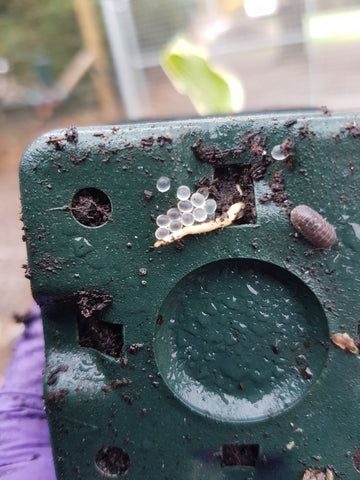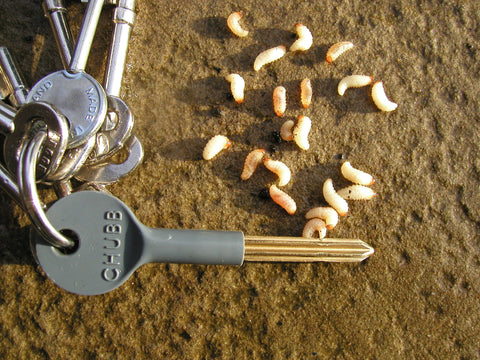
One of the reasons that we love hostas is they very rarely suffer from disease, they're easy to grow and they require rather minimal upkeep. Unfortunately, like any living thing hostas can get poorly and need assistance from us to get back on track. In this article we look at what to do when your hostas experience various issues including disease, pests, weather damage or simple neglect.
Thankfully, hostas very rarely suffer from disease, but it can happen. It is important to know when to try and save your plant, and when you should dispose of it in order to protect other plants in your garden.
HVX (Hosta Virus X) - HVX is a virus that hostas can contract; this virus can be present in the plant for years without displaying obvious symptoms. When symptoms appear they generally show as a bleeding in the leaf veins or as collapsed tissue. These symptoms aren't always virus and can instead be frost damage or flecks of colour in the leaf. If you think you have a plant infected with HVX, you may want to get a test kit before throwing it away. HVX does not kill hostas, but once they have it they will always have it so we would recommend disposing of any infected plants (not into your compost). It is very important to disinfect tools between plants when pruning, splitting etc as this will spread the virus to other hostas. Read more about HVX here.

Fungal Diseases - Fungal diseases can be common in late Summer if it is wet and warm. Effected foliage should be removed and the plant should be sprayed with a fungicide to avoid reinfection. At the end of the season, clear all of the foliage and a good amount of the top layer of soil to avoid the fungal issue overwintering and risk reinfection of next seasons shoots. Fungal problems can also be an issue earlier in the season if your plants are damaged by a late frost, this can allow disease into the leaves.
Some fungal diseases that can effect hostas include:

Weather Damage
Sometimes the weather can adversely effect hostas, whether it is extreme heat, extreme cold, heavy rainfall or lack of rainfall. With climate change we're experience these conditions more regularly than ever.
Late Frosts - Late frosts are our worse nightmare here on the nursery, this is most damaging when we've had some early warm whether in February or March that has encouraged the hostas to emerge. This early foliage is fleshy and tender making it vulnerable to damage, a late frost once the plants are in leaf can leave them looking like a sad lettuce at the back of the fridge. If your hostas get frost damaged then our advice is simple, cut them right back and let them start again. There is no point trying to resurrect damaged leaves, it isn't going to happen. Cutting your plant back will encourage new growth to come through and leave you with a fresh healthy looking plant.

Our advice is similar for hostas that have been damaged by the sun. Burnt, crispy leaves aren't attractive, so why leave them on! Remove these to free up space for new growth to come through. We've had plants that we've cut back in May/June that look amazing again by July/August.
Hail Damage - There is very little you can do to avoid hail damage as it often starts suddenly and the damage is done in a matter of seconds. Hail shreds hosta leaves like shrapnel. The only way to prevent this is to cover your hostas prior to hail, this is only possible if you know it's coming.
Pest Damage
Hostas don't have a huge amount of pests but it is good to know what to do when your hostas have been eaten/damaged.
Slugs and snails are the most common problem for hostas and it can be heartbreaking when your prized hosta gets munched. Thankfully most slug and snail damage is purely aesthetic and hostas are rarely eaten to the stage of death unless they are very young or just completely left to fend for themselves. Like most leaf damage, the best advice we can give is remove any leaves that have been eaten to allow new growth to come through and start to protect the plants with seashells, copper bands or garlic wash. Try finding and removing as many eggs in the Autumn as you can to help reduce the early Spring population. The great thing about hostas, is you always get another try next season when they come up again.

Rabbits and Deer - our best advice with rabbit and deer damage is to try and avoid it in the first place. Deer especially can eat a whole hosta in a very short amount of time and although this will not kill it, there is very little you can do when they have done this. You can purchase repellent sprays and we have heard from some customers that use our garlic wash, but the best protection is generally to keep them out of the garden if possible.

Vine weevil - these little critters are in our opinion, worse than slugs and snails. The adult beetles will cut semi circular notches out of the edges of the foliage, but it is the larvae that cause the most damage. Once hatched in the soil, the larvae proceed to eat the root system of the plant. If you have enough of an infestation it can lead to the plant dying if the root system is completely eaten. To manage vine weevil damage, firstly try and find and remove as many adult beetles as you can. In the day adult beetles hide at the base of the leaves and come out to feed in the dawn and dusk. Once you have removed as many adults, treat with nematodes in the early Autumn and early Spring to deal with the larvae. If the infestation is bad, then de-pot the plant and remove the larvae by hand and replant in fresh compost.



Hi I’ve just been on a fascinating foraging workshop with Liz Knight. One delicacy was Hosta. Do you recommend any particular hostas for particular dishes?
We have 3 hostas in a raised bed which is sheltered beneath some western red cedars. The hostas have been there about 3 years. This summer they are about half the size of normal, although have normal leaves without disease and are flowering. Could this be due to insufficient water over Winter due to the trees? Many thanks
Ali Creighton
July 13, 2025
Hi there,
Apologies, I’m going to ask about slugs.
I’m not going to kill them & we all have to live here, I’m just after a few recommendations of some of the slightly-less-likely-to-be-eaten varieties, like Blue Mouse Ears. (Medium/small size)
Thanks,
Ali